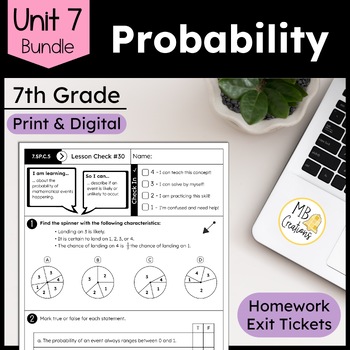7th Grade Probability Activities, Worksheets & Exit Tickets Unit 7 iReady Math
- Zip
- Easel Activity
Products in this Bundle (4)
Bonus
Also included in
- Use this yearlong 7th-grade math curriculum about ratios, negative numbers, percents, probability, and more. Whether you teach iReady Math or another curriculum, these print and digital problems align with Common Core State Standards and prepare students for standardized testing. Assign the lesson cPrice $110.00Original Price $143.65Save $33.65
Description
Teach 7th-grade students about probability with these math worksheets, exit tickets, and vocabulary activities. Whether you teach iReady Math or another curriculum, these print and digital problems align with Common Core State Standards and prepare students for standardized testing. Assign the lesson checks about probability as homework or share in small groups. Present these rigorous math questions in PowerPoint or Google Classroom through TPT Easel.
Lessons in 7th Grade iReady Math Unit 7:
- 30 - Introduction to Probability
- 31 - Solve Problems Involving Experimental Probability
- 32 - Solve Problems Involving Probability Models
- 33 - Solve Problems Involving Compound Events
Check out the Contents of Every Lesson:
✏️ Two Vocabulary Activities that align with terms in the lesson (2 worksheets)
- Students think creatively about math vocabulary terms.
✏️ Two Levels of Practice Pages (4 worksheets)
- Basic (On Level) - Provide additional practice with grade-level math.
- Advanced (Challenge) - Plunge deeper into grade-level math and apply knowledge.
- These “Lesson Checks” can be used for reteaching, independent work, assessments, centers, or math homework.
✏️ Two Exit Tickets for Every Session (Printed two/page; lessons have 3-5 sessions)
✏️ PowerPoint File
- All questions have been reformatted for screens
- The included PowerPoint file makes it easy to present immediately!
- Add interactive elements with PearDeck or Nearpod.
- Export the slides to OneNote, Google, or SeeSaw!
✏️ Answer Keys
Hear From Educators Like You!
⭐️ “You will not regret purchasing this product. They are great resources and very well planned out. I love the exit tickets.”
⭐️ “I am in love with these resources! I use the exit tickets every day and I also use the worksheets as homework and assessments.”
⭐️ “Since iReady is new to me, I needed a guide to help me with exit tickets, homework, and extra practice for my students. This does just that. It has been so useful and I am so excited to keep using this resource.”
Use These Worksheets and Exit Tickets with your iReady Classroom Math Curriculum!
✅ Differentiate instruction by assigning “Basic” (>) worksheets to students who are working on grade-level content. Challenge gifted and talented students with “Advanced” (>>) worksheets. These activities require students to dive deeper as they solve probability problems.
✅ Complete one practice page in small groups and assign a second page for homework. (Questions prepare students to master iReady Classroom Math Quizzes!)
✅ Invite early finishers to think creatively about math vocabulary through a variety of activities.
✅ Quickly assess students’ ability to solve probability problems with the exit tickets.
Find Answers about this Supplement to your 7th Grade Math Curriculum:
✋ Does my district have to use iReady Classroom Math 2024?
- No, these worksheets and exit tickets align with CCSS and provide excellent practice for students in all math classes. Don’t take my word for it… teachers like you have said, “This was awesome! I LOVE the range of problem types! My school doesn’t use iReady and I still LOVED these slides!”
✋ I use PearDeck...Google Classroom...SeeSaw... Will the digital elements work?
- Yes! Every question has been reformatted to make digital integration a breeze! Present with PearDeck, NearPod, or PowerPoint. Export the slides into SeeSaw or OneNote. It’s so easy!
Did you know? You can assign TPT Easel resources, like this unit on how to solve probability problems, to Google Classroom or share through a link!
#mbcreations #mbcreations4education #ireadymath #7thgrademath
❤️ Follow me to receive updates on new resources. ❤️
⬇️ Yearlong 7th Grade iReady Math Collection: ⬇️
- 7th Grade Math Vocabulary Banner
- 7th Grade iReady Math Unit 1 Bundle
- 7th Grade iReady Math Unit 2 Bundle
- 7th Grade iReady Math Unit 3 Bundle
- 7th Grade iReady Math Unit 4 Bundle
- 7th Grade iReady Math Unit 5 Bundle
- 7th Grade iReady Math Unit 6 Bundle
- 7th Grade iReady Math Unit 7 Bundle
- 7th Grade iReady Unit Reviews & Test Prep






